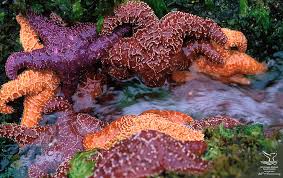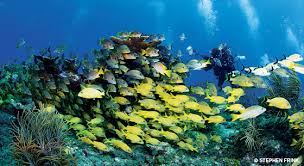Overview
Marine sanctuaries are like national parks, but in the sea or off the coast. These areas protect many species of marine wildlife, and are in many different locations, as far north as the Arctic, as far south as the Caribbean, as far west as Hawai’i and almost to the Philippines. Marine sanctuaries provide a home and protect many species from extinction, as well as places for scientists to explore hidden vistas.
Marianas Trench Marine National Monument
The Marianas Trench Marine Protected Monument covers over 95,000 square miles of the Pacific Ocean. It covers more than 1000 square miles of the deep-sea Marianas Trench, areas of mud volcanoes, the waters and submerged lands around the Northern Mariana Islands, and many other locations around the Marianas Archipelago. The Marianas Trench is the deepest part of the ocean, and much of the area is unexplored. Unusual forms of microscopic life may live under darkness and great pressure, under some of the harshest conditions on Earth.. Coral reefs in the submerged areas support many different forms of life, including more than 300 kinds of stony corals.
Papahānaumokuākea Marine National Monument
The area for this protected sanctuary is over 582,000 square miles, a larger area than all the national parks on land. It contains tiny islands, atolls, and reefs northwest of the better-known islands of Hawai’i. Many of the species that live there are only found there, including rare and endangered animals such as the monk seal, the green turtle, and the Laysan duck. Marine species share their homes with cultural treasures that are engulfed by the ocean, and archaeologists, scientists, and other explorers study the region. Its long name is a tribute to the legends of the ancestors of Hawai’ian lands and people.
Olympic Coast National Marine Sanctuary
The Olympic Coast National Marine Sanctuary is off Cape Flattery, at the northwest coast of Washington State and the Pacific Ocean. It is almost 3200 square miles, about the size of Puerto Rico. It extends out seaward between 25 and 50 miles in some places, from the continental shelf to some submarine canyons. It is a rich area of sealife that live in the intertidal areas. Over 25 different types of marine mammals live there, including pods of orca whales, endangered gray whales, deep sea coral and sponges, and varieties of seabirds.
Monterey Bay National Marine Sanctuary
The Monterey Bay National Marine Sanctuary has over 275 square miles of shoreline and over 5300 square miles of open ocean off the coast of Monterey, California, from north of San Francisco to the southern end of Big Sur. It consists of rich feeding grounds for a number of species that live in tide pools, coastal wetlands, kelp forests, and submarine canyons. There are over 34 types of marine mammals, more than 180 different types of seabirds, over 500 different types of fish, seaweeds, and other marine life.
Interested in science tutoring services? Learn more about how we are assisting thousands of students each academic year.
SchoolTutoring Academy is the premier educational services company for K-12 and college students. We offer tutoring programs for students in K-12, AP classes, and college. To learn more about how we help parents and students in Washington, DC visit: Tutoring in Washington, DC



